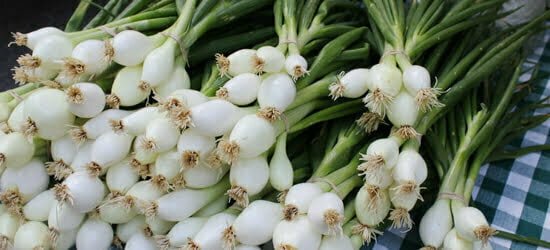Memorial Day marks the unofficial kickoff to summer (even if by the calendar we’re still four weeks out) and, just in time, summer squash has made its first market appearances. We spotted baby zephyr, zucchini, and pattypan varieties this past week from Olivette Farm (Asheville City Market) and Full Sun Farm (North Asheville Tailgate Market, River Arts District Farmers Market), and more farms will have it soon.
Other seasonal finds picking up speed are spring alliums. Wondering about the differences between all the spring onions, scallions, leeks, green garlic, and garlic scapes filling up market tables? Here’s a quick rundown.
Scallions (also called green onions) have thin, tubular green shoots with a white root end. Depending on the type, scallions may be early-harvested spring onions, or might be a variety that never matures into the more bulbous spring onion. Though peppery, scallions are fairly mild on the onion spectrum, and can be eaten raw, charred, or sautéed. They are often relegated to a garnish, but also form the basis of many Chinese dishes. Spring onions are more pungent, but sweeter than regular onions, and are delicious grilled or roasted whole as a quintessential springtime side dish. You can eat both the bulb (which could be white or red) and the green shoots.
Leeks—as well as baby leeks, which often show up at market at this time of year and can be confused with scallions—don’t grow an underground bulb as onions do. They are long and straight, and we generally eat the white and pale green parts. The taste falls between onions and garlic. Leeks are crunchier than scallions or spring onions, and so hold up to longer cooking techniques, like braising, but aren’t usually eaten raw. They can be cooked whole or sliced thinly. It’s important to wash leeks well, as a lot of dirt can hide between the layers.
Green garlic looks strikingly similar to scallions, but is actually regular garlic harvested early before the head has matured. You can tell the difference in the smell, as well as by the leaves, which are flat instead of tubular. Green garlic can be used anywhere you would use regular garlic, but it’s particularly fitted to delicate herb sauces or dressings where its milder flavor can sing. Garlic scapes appear a bit later in the season, and are the curly shoots that extend out of the garlic plant with closed buds on top. These wild-looking bunches are more potent than green garlic, but can still be eaten raw (pesto is a good use) or cooked (grilling or sautéing works well).
If you have other questions about lesser-known garlic varieties, seek out Go Garlic, a Polk County-based farm specializing in that single crop. Go Garlic can also be found at several area farmers tailgate markets, including in Asheville at the River Arts District Farmers Market on alternating Wednesdays (look for the farm’s current market schedule on their website, gogarlicnc.com).
You’ll still find strawberries, rhubarb, snap peas, new potatoes, tender salad greens, lettuces, kale, chard, collards, beets, and more at markets right now. Grill-ready meats, like chicken, steaks, and pork chops, are in plentiful supply, as are staples like eggs, bread, and value-added products.
Area farmers tailgate markets take place throughout the region. As always, you can find information about farms, tailgate markets, and farm stands, including locations and hours, by visiting ASAP’s online Local Food Guide at appalachiangrown.org.

